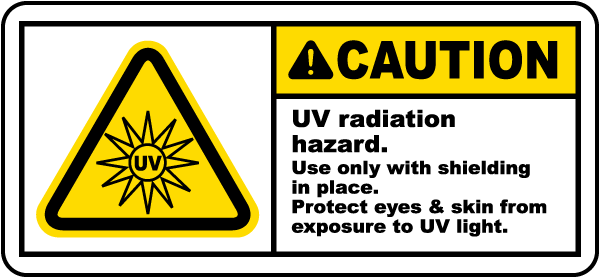LUYOR-3109高强度紫外催化光源促销
LUYOR-3109紫外光源采用了9颗365nm大功率led,安装有二次光学透镜,输出紫外线强度高,...
2024-08-08作者:时间:2019-12-17 08:58:35浏览7630 次
实验室中的紫外线产生源包括但不限于核酸透射仪和紫外交联仪,手持式紫外线灯,生物安全柜中和安装在天花板上的杀菌灯,紫外线灯箱和紫外线激光器。暴露于紫外线辐射会在裸露的皮肤内引发称为红斑的光化学反应。曾被晒伤的任何人都可能熟悉急性效应。这种“晒伤”可能非常严重,并且可能由于仅几秒钟的暴露而发生。长期暴露于紫外线辐射的皮肤与皮肤过早衰老,皱纹和皮肤癌有关。
实验室中的紫外线来源和危害
紫外线(UV)是非电离辐射,空气中的波长在电磁光谱的180到400纳米(nm)区域之间,仅在可见范围之外。有三个值得关注的紫外线区域:UV-A(315-400 nm,黑光区域,更低潜在危害),UV-B(280-315 nm,红斑区域,中到高潜在危害)和UV-C (180-280 nm,杀菌区域,更高潜在危害)。
紫外线可能与健康影响相关,具体取决于暴露时间和波长。暴露于紫外线通常仅限于阳光直射导致的紫外线区域。地球大气层使我们免受有害的UV-C和99%的UV-B的伤害。实验室工作人员可能正在使用能够在所有三个区域产生紫外线辐射的设备。因此,工人必须使用适当的控制措施以防止受伤。
实验室中紫外线的常见来源
实验室中的紫外线产生源包括但不限于核酸透射仪和紫外交联仪,手持式紫外线灯,生物安全柜中和安装在天花板上的杀菌灯,紫外线灯箱和紫外线激光器。
暴露在紫外线下的危害
意外的紫外线过度暴露会伤害不知情的受害者,因为紫外线是不可见的,不会立即产生反应。过度接触的症状包括不同程度的皮肤和眼睛受伤。
皮肤伤害 –暴露于紫外线辐射会在裸露的皮肤内引发称为红斑的光化学反应。曾被晒伤的任何人都可能熟悉急性效应。这种“晒伤”可能非常严重,并且可能由于仅几秒钟的暴露而发生。长期暴露于紫外线辐射的皮肤与皮肤过早衰老,皱纹和皮肤癌有关。
眼睛受伤 –暴露于紫外线辐射会导致光性角膜炎,这是由紫外线辐射引起的角膜病变引起的眼睛疼痛性炎症。症状包括可能持续数天的眼睛沙粒感。长期暴露于急性高能紫外线辐射下会导致白内障的形成。
接触极限
华盛顿州劳动和工业部(L&I)已确定了眼睛和皮肤暴露于电弧,气体和蒸气放电以及白炽灯产生的紫外线辐射的限值。这些限制与应用于激光的限制不同,并且不包括太阳辐射。为了减少伤害,工人必须将暴露控制在这些限值以下。
极限曝光
切勿让皮肤或眼睛暴露于实验室设备产生的紫外线辐射下。为控制紫外线暴露,请适当屏蔽光源,要求用户穿戴适当的个人防护设备,并在可能的情况下,在进入实验室之前关闭产生紫外线的设备。
个人防护装备(PPE)
为了防紫外线,请穿着适当的实验室服装,包括完全扣紧的实验室外套,手套,长裤,露趾鞋和帽子。防止通常在脖子和手腕区域周围出现的防护服上的缝隙。如果眼睛和脸部有暴露的可能,则应佩戴适当的紫外线防护眼和脸部防护装置。
特殊工作惯例
杀菌灯打开时,切勿在生物安全柜中工作。如果可能,请在灯亮时关闭窗扇。
切勿在没有防护罩的情况下使用透射照明器。保持屏蔽层清洁,损坏时应更换。
如果门安全联锁不能正常工作,切勿使用交联剂。
请遵循制造商的说明进行维护和保养。
制定并遵循标准的操作程序。
标签/标牌
紫外线光源必须在光源外壳上贴上明显的标签,并带有适当的警告或警告提示:
“注意–紫外线辐射危害,仅在与遮盖物,保护眼睛和皮肤接触暴露后进入紫外线的情况下使用”
如果实验室中有产生紫外线的光源,则除了标签外,入口还应显示实验室标牌,指示危险(例如,紫外线,激光等),进入所需的PPE以及任何其他信息(请参见实验室标牌计划。)
监控方式
尽管EH&S并未对紫外线辐射进行常规监控,但仍有手持式仪器可准确测量实验室设备产生的紫外线辐射。
获得协助
EH&S可应要求提供培训。EH&S将调查报告的过度接触,进行监控(如果适用),并提供建议以防止再次发生。如果您对紫外线危害,暴露极限,监控,PPE或紫外线激光有疑问,或者需要标签和标识,请与您的EH&S办公室联系。
美国路阳中国公司销售多种实验室紫外线光源和紫外线防护用品,如果对紫外线光源和紫外线防护眼镜、紫外线防护面罩感兴趣,请和我们销售客服咨询。
实验室中的紫外线来源和危害的英文:
Ultraviolet Light in Laboratories: Sources & Hazards
Ultraviolet light (UV) is non-ionizing radiation with wavelengths in air between the 180 to 400 nanometer (nm) region of the electromagnetic spectrum, just outside the visible range. There are three UV regions of concern: UV-A (315- 400 nm, black-light region, lowest potential hazard), UV-B (280-315 nm, erythema region, mid to high potential hazard), and UV-C (180-280 nm, germicidal region, highest potential hazard).
UV can be associated with health effects depending on exposure duration and wavelength. Exposure to UV is typically limited to the UVA region resulting from direct sunlight. The Earth’s atmosphere shields us from the more harmful UV-C and 99% of UV-B. Laboratory workers may be using equipment capable of generating UV radiation in all three regions; therefore, workers must use the appropriate controls to prevent injury.
Common Sources of UV in Laboratories
UV generating sources in laboratories include, but are not limited to, nucleic acid transilluminators and crosslinkers, hand-held UV units, germicidal lamps in biological safety cabinets and installed on ceilings, UV light boxes, and UV lasers.
Hazards Associated with Exposure to UV
Accidental UV overexposure can injure unaware victims because UV is invisible and does not produce an immediate reaction. Symptoms of overexposure include varying degrees of skin and eye injuries.
Skin injury – exposure to UV radiation can initiate a photochemical reaction called erythema within exposed skin. Acute effects may be familiar to anyone ever having been sunburned. This “sunburn” can be quite severe and can occur as a result of only a few seconds of exposure. Chronic skin exposure to UV radiation has been linked to premature skin aging, wrinkles, and skin cancer.
Eye injury – UV radiation exposure can cause photokeratitis, a painful inflammation of the eye caused by UV radiation-induced lesions on the cornea. Symptoms include a sensation of sand in the eye that may last for days. Chronic exposures to acute high-energy UV radiation can lead to the formation of cataracts.
Exposure Limits
Washington State Department of Labor and Industries (L&I) has established limits for eye and skin exposure to UV radiation produced from arcs, gas, and vapor discharges, and incandescent sources. These limits differ from those applied to lasers and do not include solar radiation. To reduce injuries, workers must control exposures to levels below these limits.
Limiting Exposure
Never allow the skin or eyes to be exposed to UV radiation generated by laboratory equipment. To control UV exposure, properly shield the source, require the user wear appropriate personal protective equipment, and whenever possible, turn off UV-generating equipment before entering the laboratory.
Personal Protective Equipment (PPE)
For protection against UV, wear appropriate laboratory apparel, including a fully buttoned lab coat, gloves, long pants, closed-toe shoes, and cap. Prevent gaps in protective clothing that commonly occur around the neck and wrist areas. If there is any potential for the eyes and face to be exposed, proper UV shielding eye and face protection should be worn.
Special Work Practices
Never work in a biological safety cabinet while the germicidal lamp is on. If possible, close the sash when the light is on.
Never use a transilluminator without the protective shield in place. Keep shields clean and replace when damaged.
Never use crosslinkers if the door safety interlock is not working properly.
Follow manufacturer’s instructions for maintenance and servicing.
Develop and follow standard operating procedures.
Label/Signage
UV sources must be conspicuously labeled with an appropriate caution or warning notice attached to the housing of the source:
“CAUTION – UV RADIATION HAZARD, USE ONLY WITH SHIELDING IN PLACE, PROTECT EYES AND SKIN FROM EXPOSURE TO UV LIGHT”

If there is a UV-generating source in the laboratory, in addition to the label, the entrance should display a laboratory sign indicating hazards (i.e., UV light, laser, etc.), PPE required to enter, and any additional information (see Laboratory Signage Program.
Monitoring
Although EH&S does not conduct routine monitoring for UV radiation, there are hand-held instruments to accurately measure UV radiation generated by laboratory equipment.
Getting Assistance
EH&S is available to provide training when requested. EH&S will investigate reported over-exposures, conduct monitoring (if applicable), and provide recommendations to prevent re-occurrences. If you have questions regarding UV hazards, exposure limits, monitoring, PPE or UV Lasers, or need labels and signage, contact your EH&S office.